We do more than dance...
Just in case you have a special request, here are some navigational tools
- A Real Sporting Goods Store
- Little League Baseball
- Hurling
- Cricket
- Lacrosse
- Decathlon
- Ice Hockey
- Field Hockey
- American Football
- Racquet Sports
- Skiing
- Polo
- Fencing
In addition to this page on sports memorabilia, we have a Calendar of Swing Dancing in DC, a Directory of Vintage Clothing Stores and a Guide to 1940s Collectibles. Thanks for tuning in! Feel free to Contact Me if you have questions or want to share photographs and sports stories with the rest of the readers.
A Real Sporting Goods Store
As of 2011, most "sports stores" are big box items that mainly push expensive sneakers. Back in the 1930s, there were real "Sporting Goods Stores" that sold all kind of interesting things. We were really pleased when our friend Acme Ron sent us this photograph, probably from the 1930s.
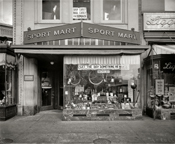
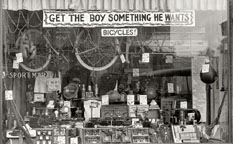

The Sport Mart
They even had a chess set...
Click to Enlarge
We love the slogan "Get the Boy Something He Wants". We have enlarged the photo to give you an idea of the variety of merchandise on display, that ran the gamut from a punching bag to a chess set.
Little League
Like most red-blooded boys of the 1950s, I participated in Little League. I played for the Brown and Vaughn Tigers for one season. Messrs. Brown and Vaughn were suburban developers in the early 1950s in and around Pittsburgh. Here is a photo of me in my ill-fitting uniform:

The Brown & Vaughn Tiger
(click to enlarge)
I like baseball, both as a player and a spectator. When we lived in the City, I played nearly every day on the "playground" that was available to poor kids. It was a large vacant lot next to St. John's Church that had been soaked in oil (yes, road oil...) to keep it from blowing away. We enjoyed our games there and came home filthy. Since all the older men had to work, we got used to a form of self-governance. The biggest kids made the rules. If you didn't like it, you could get a black eye. Since big kids were fairly evenly distributed among the various teams, a sort of mutually assured destruction kept the games almost fair. When we moved to the Suburbs, it was somewhat different. The fields were lush grass, and we had the trappings of real baseball such as dugouts, scoreboards and a real umpire. Unfortunately, many fathers found the time to attend the games and shamelessly promote their own sons. I had my share of successes and failures, most of which provoked someone else's father to scream at me, most of the time with a bright red face. If I hit a home run, I spoiled some kid's ERA. If I dropped a fly ball, I made someone elses's son look bad. I didn't mind taking gaff from bigh tough kids. It was another thing to be harassed by adults. After retaliating a few times by sticking nails in tires, I decided that I didn't want to play for Brown and Vaughn anymore. If I had a free day, I'd ride my bike to the streetcar and go back to my old neighborhood to play on the oiled dirt.
At that time, the Pirates played day games, so it was also possible to take the streetcar to Forbes Field and sit in the "nosebleed" section of the outfield bleachers for a quarter. At that time, families could bring large hampers of food into the ballpark (concession revenue was not the principal source of the team's income...) With clockwork regularity, an Italian or Polish mother would take pity on a lonely kid and stuff him with all sorts of delicacies. Food notwithstanding, the best part of a Pirates game was the end, when the players would gather along the first base-line, talk to the kids and sign autographs. My HERO was Ralh Kiner.
Before I proceed, here is some stuff about Ralph that you should know:
"...Kiner was born in Santa Rita, New Mexico, and grew up in Alhambra, California. He made his major league debut on April 16, 1946 with the Pittsburgh Pirates. In 1947, he gained notice for hitting 51 home runs. Many of Kiner's homers were hit into a shortened left-field and left-center-field porch at Forbes Field, originally built for Hank Greenberg, and known in the press as "Greenberg Gardens"; the porch was retained for Kiner and redubbed by the media as 'Kiner's Korner'. In 1949, Kiner topped his 1947 total with 54 home runs, falling just two short of Hack Wilson's National League record. It was the highest total in the major leagues from 1939 to 1960, and the highest National League total from 1931 to 1997. It made Kiner the first National League player with two fifty-plus seasons. Kiner also matched his peak of 127 RBIs. From 1947 to 1951, Kiner topped 40 home runs and 100 RBIs each season. His string of seasons leading the league in home runs reached seven in 1952, when he hit 37. This was also the last of a record six consecutive seasons in which he led Major League Baseball in home runs, all under the guidance of manager Billy Meyer and Pirate great Honus Wagner. He was selected to participate in the All-Star Game in six straight seasons, 1948 to 1953. He holds (by himself) the major league record of eight home runs in four consecutive multi-homer games, a mark that he set in September, 1947. A quote variously attributed to Kiner himself, as well as to teammates talking about Kiner, was 'Home run hitters drive Cadillacs and singles hitters drive Fords.' Footage of Kiner hitting a homer in Forbes Field can be seen in the 1951 film, Angels in the Outfield...."
It was a great thrill to shake hands with Kiner and to ask him to sign anything at hand. As shown below, I got him to sign my bat, a baseball that I caught in the stands, and a scrap of paper, all of which I have suitably enshrined in my office.
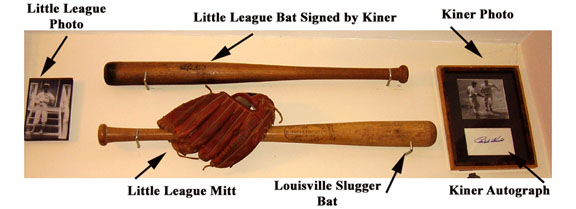
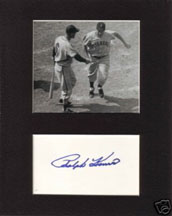
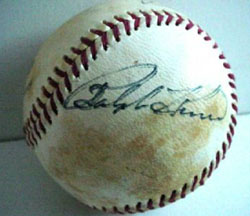
Ralph Kiner Artifacts
Treasures from my Youth
(click to enlarge)
I can never quite relate to these antiseptic new ball fields, even the retro-themed ones like Camden yards. I prefer minor league baseball, especially the Frederick Keys.
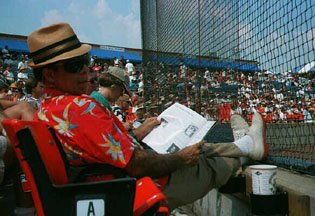
Relaxing at a Frederick Keys Game
(click to enlarge)
Here I am, sitting behind Home Plate relaxing with a scorexard and a cup of coffee. The seats were $5 after I showed my Safeway Savings Card.
Hurling
When I was in the oil business, I had to do a lot of traveling. One of my trips brought me to Ireland where I was introduced to the sport of hurling. At the risk of being culturally insensitive, my first impression was that the game consisted of big guys hitting each other with nasty looking sticks. After watching the game for a while, and becoming more familiar with it, I found it to be quite interesting -- a lot more exciting than soccer. I even spent some time on a weekend trying my hand at it; some of my experience with lacrosse (below) transferred, so I didn't make a complete fool of myself. The bruises that i got confirmed that it is a contact sport, but I came away with (a) an appreciation of the skill required and (b) a souvenir caman, as shown below.
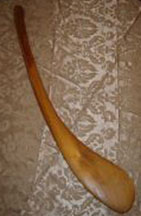
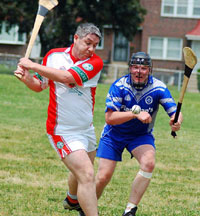
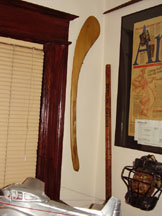
The caman or hurley
(left)Closeup of the Caman
(middle)The Caman in use
(right)The Caman on the South wall of my office (click to enlarge)
Hurling (in Gaelic, iománaíocht or iomáint) is an outdoor team sport of ancient Gaelic origin. The game, played primarily in Ireland, has prehistoric origins and is the world's fastest field team sport in terms of game play. One of Ireland's native Gaelic games, it shares a number of features with Gaelic football, such as the field and goals, number of players, and much terminology. There is a similar game for women called camogie (camógaíocht).
The object of the game is for players to use a stick called a hurley or hurl (in Gaelic a camán, pronounced ["kuh-mon"]) to hit a small ball called a sliotar (pronounced "slah-tur") between the opponents' goalposts either over the crossbar for one point, or under the crossbar into a net guarded by a goalkeeper for one goal, which is equivalent to three points. The sliotar can be caught in the hand and carried for not more than three steps, struck in the air, or struck on the ground with the hurley. It can be kicked or slapped with an open hand (the hand pass) for short-range passing. A player who wants to carry the ball for more than three steps has to bounce or balance the sliotar on the end of the stick (this is often called "going solo"), and the ball can only be handled twice while in his possession. Side to side shouldering is allowed although body-checking or shoulder-charging is illegal. No protective padding is worn by players, and although a plastic protective helmet with faceguard is recommended, this is not mandatory for players over 19. Here is a Video that explains more about the sport of Hurling.
Hurling is represented in some form on all continents apart from Antarctica and is popular among members of the Irish diaspora in the United Kingdom, North America, Europe, Australia, New Zealand, South Africa and Argentina.
Policemen often refer to their night-stick as a "Come-On" -- prior to experiencing the world of Hurling, I always thought that this term meant "something to assist the officer in escorting his prisoner to the jail." Since the Irish have contributed disproportionately to the ranks of police officers, I suspect that "Come-On" is actually derived from the camán
Those of you who would like to know more about this fascinating sport should consult the website of the Gaelic Athletic Association.
Cricket
My travels also took me to a number of countries, all parts of the Former British Empire, and I guess now part of the Commonwealth of Nations. Along with tea in the afternoon and the stiff upper lip, the British left Cricket as a legacy in all these disparate countries. This sport is much more refined than Hurling and often includes time for tea breaks. It is one of the few games that has an indeterminate length. The Brits, inventors of cholera blankets and the opium trade, have infused the game with lots of jolly Good Sportsmanship.
For the record, cricket is a bat-and-ball team sport that originated in southern England. The earliest definite reference is dated 1598, and it is now played in more than 100 countries. Given the fact that it has been played for more than 400 years, a large accretion of customs and rules have become attached to the game -- as well as arcane and obfuscating terminology. There are several forms of cricket; at its highest level is Test cricket, in which the current leading national team is Australia. Test cricket is followed in rank by One Day International cricket, whose last World Cup was also won by Australia; the tournament was televised in over 200 countries to a viewing audience estimated at more than two billion viewers. It is only fitting that former Colonies like Australia (once a dumping ground for convicts), India, and Jamaica should have world preeminence in the sport.
A cricket match is contested by two teams, usually of eleven players each, and is played on a grass field in the centre of which is a flat strip of ground 22 yards long called a pitch. A wicket, usually made of wood, is placed at each end of the pitch and used as a target. The bowler, a player from the fielding team, bowls a hard leather, fist-sized, 5.5 ounces cricket ball from the vicinity of one wicket towards the other, which is guarded by the batsman, a player from the opposing team. The ball usually bounces once before reaching the batsman. In defence of his wicket, the batsman plays the ball with a wooden cricket bat. Meanwhile, the other members of the bowler's team stand in various positions around the field as fielders, players who retrieve the ball in an effort to stop the batsman scoring runs, and if possible to get him or her out. The batsman—if he or she does not get out—may run between the wickets, exchanging ends with a second batsman (the "non-striker"), who has been stationed at the other end of the pitch. Each completed exchange of ends scores one run. Runs are also scored if the batsman hits the ball to the boundary of the playing area. The number of runs scored and the number of players out are the main factors that determine the eventual match result.To delve further into the mysteries of Cricket, check out the website of the International Cricket Council, headquartered in Dubai.
My own personal experience with cricket comes from an afternoon of awkwardly embarassing play pitting a group of aging Yanks against an equally superannuated group of Oxonians at an Energy Modeling Forum meeting in Oxford. I brought home the cricket bat shown below as a souvenir.

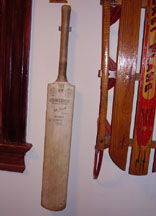

The John Edrich Cricket Bat
(click to enlarge)
John Hugh Edrich MBE (born 21 June 1937 in Blofield, Norfolk) is a former English cricketer who played for Surrey and England. He earned a reputation as a dogged and fearless batsman, and his figures show that he was amongst the best players of his generation. He played a total of 77 Test matches for England in an international career lasting from 1963 to 1976. He once completed a game with a fractured skull caused by a wild pitch. He came from a cricketing family, his four cousins Eric Edrich, Bill Edrich, Geoff Edrich and Brian Edrich all having played first-class cricket. He was educated at Bracondale Private School from the ages of 8 to 17, during which time he played cricket at weekends.
Lacrosse
I grew up in Western pennsylvania where lacrosse is not particularly popular. However, when I started teaching at the University of Virginia, I was introduced to the intramural version of this sport. I played off and on for about three years. While travelling in Canada, I found this antique crosse and I have it on the wall of my office.
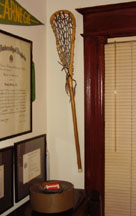
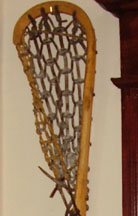
Antique Crosse (Bent Ash and Leather)
(click to enlarge)
Lacrosse is played using a solid rubber ball and long handled racket called a crosse (aka lacrosse stick.) The head of the crosse has a loose net strung into it that allows the player to hold the lacrosse ball. Offensively the object of the game is to use the lacrosse stick to catch, carry, and pass the ball in an effort to score by ultimately hurling the ball into an opponent's goal. Defensively the object is to keep the opposing team from scoring and to dispossess them of the ball through the use of stick checking and body contact. If you want to learn more, check out the website of the International Lacrosse Federation
Decathlon
When I was in High School, I was really skinny. I had some success at track and field events. I was pretty good at distance running and (somewhat unusually) also the sprints, particularly the hurdles. Our high school was quite small, and the coach had me run the second lap of the 4x100 Relay. In competition against lesser teams, I ran the 100 yard dash, saving our best for the 220 and 440. I even won a few of those races. Most sprinters also practice the jumps and I had attained fair performance in the Long and High jumps. I was always fascinated by the Pole Vault and spent a summer working out with one of the guys who was pretty good at it. The new tubular metal poles had just become legal, and they began to favor smaller guys. When I showed off my new skill to the coach, he got the idea that I might do well in the Decathlon. For those of you who are not familiar with this event, here is some background:
The decathlon is an athletic event consisting of ten track and field events. Events are held over two consecutive days and the winners are determined by the combined performance in all. Performance is judged on a points system in each event, not by the position achieved. The word decathlon is of Greek origin (from deka [ten] and athlos [contest]). The decathlon is contested by male athletes, while female athletes contest the heptathlon (seven events). Here are the Men's events:
Day 1 Day 2100 meters 110 meter hurdles
Long Jump Discus
Shot Put Pole Vault
High Jump Javelin
400 meters 1500 meters
My first reaction was that it was silly because I really couldn't do the weight events. Coach explained the complicated scoring formula that would balance mediocre performance in the weights against good performance in the running events, since the big musclebound guys who could excel at shot-put couldn't do diddly at 1500 meters. The Pole Vault and the Jumps would be the separators. The fact that the cross-country team (of which I was a member) had won the State Championship didn't hurt...
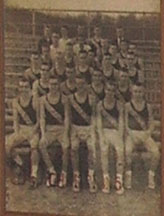
The 1960 WPIAL/PIAA Cross-Country Champions
(click to enlarge)
So, I spent the winter training to get up to speed on the Javelin and Discus, events where I might have some chance of competing with the big guys. (I didn't even try to do the shot put.)
.With Bob Mathias as my new ideal, I gave the decathlon my best effort in my senior year. I won some meets against smaller schools and even got fourth place at the regionals. After that, I gave up the decathlon, mainly because it took too much time. But, I hung on to my javelin and discus the whole time, mainly because they were so expensive. Pictures of them are shown below.
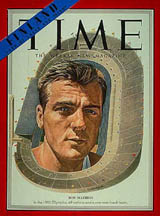
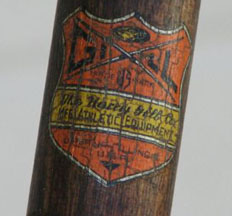
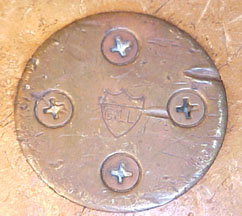
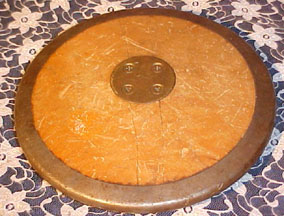
The Harry Gill Sports Company was founded in 1918
They were the Best, But they were Expensive
(click to enlarge)
Harry Gill was probably the greatest athlete of turn-of-the-century America, and probably the greatest track coach ever. Gill was thrust into the amateur track and field spotlight at the turn of the century when he easily defeated the three-time U.S. champion in the "all around"- an event equivalent to today's Olympic decathlon. Four years later Gill was hired to be the head track coach for the University of Illinois, a position that he held for some thirty years. During this time he organized (and won) the first NCAA track meet, his team won 19 Big Ten championships, and accumulated an impressive record of winning 111 meets out of 135. Although he never coached an Olympic track team, at the 1924 Paris Games, his men from Illinois outscored every other group of nations.
Gill had become so dissatisfied with American equipment by 1918 that he started into production of his own, the first item being an ash javelin. It was so well-received that he expanded into other products, offering a full line of track and field equipment by 1922.
His desire for excellence in competition led to a number of innovations and improvements in track equipment over the years. Gill Sports Equipment developed a flex test so that poles could be matched to the vaulter's weight, and an aluminum and brass alloy pole which allowed Bob Richards to be the only repeat gold medalist in the vault (1952 and 1956). Gill has several hurdle improvements to enhance safety that led to the first tubular steel hurdle. Revolutionary designs also include both the high-heeled starting blocks and those with adjustable pedals, and the Hollowood wood center discus that enabled Jay Sylvester to set two world records in 1968.
Traditionally, the title of "World's Greatest Athlete" has been given to the man who wins the decathlon. This began when King Gustav V of Sweden told Jim Thorpe, "You, sir, are the World's Greatest Athlete" after Thorpe won the decathlon at the Stockholm Olympics in 1912. The current holder of the title is American Bryan Clay, the gold medal winner of the event at the 2008 Beijing Olympics, who took the title from Athens Olympics champion Roman Šebrle.
Ice Hockey
Since I grew up in Pittsburgh, I didn't have a whole lot of opportunity to play hockey. Occasionally, a large pond at North Park would freeze up pretty solid and we would go ice skating. On occasion, guys from more northerly states would bring hockey sticks and we'd bat the puck around. Pittsburgh had a minor league hockey team (the Hornets) who would play at the old Duquesne Gardens downtown. Since this was accessible by streetcar, it was possible to attend day games when school was out. I like hockey a a spectator sport, but it is also a lot of fun to play. When I was a freshman at Carnegie Tech, a group of enthusiasts tried to start a team. The Institute was not big on athletics and the team floundered because the Gardens could only give us rink time on an intermittent basis. As I recall, we played a game or two against a ritzy suburban high school that had access to a skating rink. We got clobbered. The best part of the endeavor was the times that we got to skate with the Hornets. The great goalie Clyde Ciccarelli signed my stick.
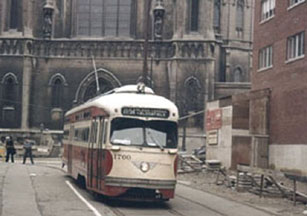
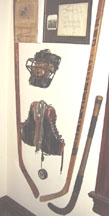
Hockey Memorabilia
The Flying Fraction outside the Duquesne Gardens
Ciccarelli (left) and Lemieux (right) Autographed sticks, Skates, Souvenir Puck
Carved cocoanut head in catchers mask
Plans for the Navion Model Airplane and framed letter from William Winter
(click to enlarge)
When the Pittsburgh Penguins were on their way to the Stanley Cup, I made a point of attending all their games played in DC. Occasionally, my work took me to Pittsburgh and I went to great lengths to see a game or to at the "Igloo" (aka the Civic Arena). I attended a charity function and was successful in bidding on a stick autographed by Mario Lemieux. I have my old skates, the Ciccarelli and Lemieux sticks and a souvenir puck from Pittsburgh's first Stanley Cup season on my office wall. (You'll also a carved cocoanut head wearing a catcher's mask -- that came from my Dad who made it while he was on Saipan during World War II.)
Field Hockey
Field hockey is a lot like Ice Hockey except that it is played on a grass field (pitch) with a ball instead of a puck. Sticks are smaller and curved
In the United States, Field Hockey is mostly the preserve of girls at swanky private schools. However, in other countries, it is a fairly rough and tumble sport played by men. Australia, India and Pakistan have historically been powerhouses in this game. In fact, a trip to Pakistan found me slugging it out with some colleagues on a pitch near Islamabad. My training in Ice Hockey paid off, although the game had a lot of similarities to Hurling as well, especially in the amount of contact. This is no game for weaklings or sissies, and you have to be in top physical condition, because it moves very fast and you are running all the time. I brought an antique stick home as a souvenir.

Field Hockey Stick
(click to enlarge)
Games played with curved sticks and a ball have been found throughout history and the world. There are 4000-year-old drawings from Egypt. (Hurling only dates to before 1272BC.) There is a depiction from 500BC in Ancient Greece when the game was called "kerytezin" because it was played with a horn ("keryos" in Greek) and a ball-like object. In Inner Mongolia, China, the Daur people have been playing Beikou (a game similar to modern field hockey) for about 1,000 years. There were hockey-like games throughout Europe during the Middle Ages[citation needed] and the word 'hockey' was recorded in the Galway Statutes of 1527. If you'd like to know more about field hockey, check out the website of the World Hockey Association.
American Football
I was always small and didn't play football in high school, although I was always up for a game of touch football, especially when it became fashionable during the Kennedy Administration. In general, my connection with Football has been that of a spectator. My Dad and I sat through innumerable losses by the Pittsburgh Steelers when they played at Forbes Field or Pitt Stadium, dismal days enlivened only by Bobby "Night Train" Lane and Eugene "Big Daddy" Lipscomb.
My only football souvenir is a ball autographed by the 1978 Redskins, during the Jack Pardee era. It was offered at auction at a fundraiser for the Washington Opera (of all things). I think that I got it for $25, opera buffs not being big football fans... Candidly, I prefer Opera to Football, as well, since the sport has degenerated to "Our Overpaid Thugs Against Your Overpaid Thugs." The game has become so big, and so commercial (even at the college level) that no average kid can envision even hoping to play. That is, a normal kid can aspire to being a brain surgeon or President, but unless he weighs 200 pounds at age 11, he isn't going anywhere in Football.
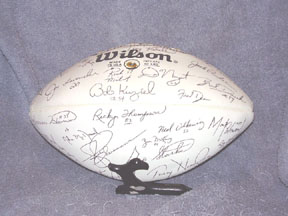
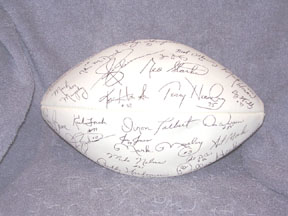
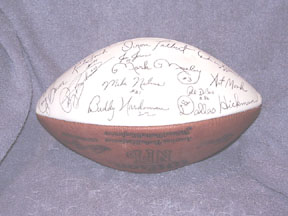
Redskins Autographed Football c. 1978
(top)Jack Pardee, Joe Lavender, Bob Kunziel
(mid) Joe Theismann,George Stark, Diron Talbert
(bottom) Mark Mosely,, Art Monk, Dallas Hickman
(click to enlarge)
This was a really great way to spend $25!
Racquet Sports
I have always been a fan of all racquet sports, including Ping Pong, Squash and Tennis. I attained some recognition in Squash during the 1960s and I still play today.
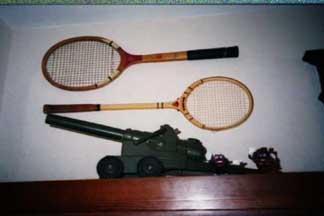
Racquet Sports
also, the Big Bang Carbide Cannon
and the California Raisins...
Click to Enlarge
Moody Squash Racquet Starting in 1927, Helen Wills Moody got a five-year vice grip on major tournament titles. She was given the nickname "Little Miss Poker Face" for her methodical play and, reportedly, because she rarely smiled. her very famous name became associated with a line of very high quality racquet sport goods. Initially, they were targeted toward women, but the excellent reputation led the company to start a line of men's equipment as well. The company enjoyed a particularly good reputation in the sport of Squash Racquets. In the mid 1960s, I played squash at the Pittsburgh Athletic Club. I was given this racquet by a friend. It is the Moody Magma, well liked by enthusiasts for its exceptional stability, durability and control. The head is made of alternating layers of birch and beech and allows you to string the racquet very tightly, something that I prefer for getting topspin onthe ball. I used this racquet on the day that I won a lottery to play a game with Hashim Khan, possibly the worlds greatest ever Squah Racquets player. (I scored just one point, and I still cherish the ball from that game) Mr. Khan elevated the game from athletics to poetry. It was the thrill of a lifetime to be on the same court with him. You should really click here to learn more about the remarkable Khan family.
Wilson "Don Budge" Tennis Racket: In 1938, American amateur Don Budge became the first player to win the singles title in the four major tournaments -- Wimbledon, French Championships, U.S. Nationals and Australian Championships -- in the same year. Writer Alison Danzig coined the term "Grand Slam" to describe Budge's feat. A steady force in men's tennis during the late 1930s, he made a comeback after a major World War II injury. Budge won his last title, U.S. Clay Court Championships, in 1955. There was, in fact, no name more associated with tennis than Don Budge, and it was quite natural that Wilson would issue a racket bearing his name. I was given this in about 1956 by my Aunt Helen, along with a complete set of Tennis Whites. This is all part of one of the strangest social experiments of all time. For some unknown reason, the City of Pittsburgh thought that tennis would be an alternative to juvenile delinquency; accordingly, courts were built in poor neighborhoods (like mine) and instruction was made available for all. I thought that this was a very nice idea. I really wasn't going to be a delinquent, but tennis got me in touch with some very nice people. I certainly don't think that the city's money was wasted.
The Big Bang Carbide Cannon: This is a 155MM Cannon (Introduced in 1958)Mounted on eight heavy duty rubber tractor wheels with a simulated hydraulic lifter. It features an automatic charger mechanism for rapid multiple firing. It is made of cast iron and sheet metal. It is 25 inches long x 7 inches wide x 6.5 inches high. It Weighs 6 lbs.
You may remember these from your childhood. Big Bang cannons have been in continuous production since 1912. They were the SOURCE of the scientific term ( "Big Bang") for the origin of the Universe. Big Bang cannons are fired by putting water in the barrel housing and then adding a measured amount of Bangsite (carbide powder). The powder dissolves in the water creating acetylene gas. The gas is then ignited by a spark....resulting in a safe and ETREMELY LOUD loud BOOM. BIG-BANG® Cannons are made by The Conestoga Company, Inc., which has been based in the Lehigh Valley, Pennsylvania, since its founding in 1912. The Conestoga Company, Inc. has survived two World Wars, the Great Depression, and the high-tech revolution that put out to pasture many similar toys from that simpler age.
In 1907, a young assistant professor of physics at Lehigh University, James Hunter Wily, patented the carbide cannon. Soon he saw the value of his invention as a safe and sane toy, and in 1912, started manufacturing BIG-BANG® Cannons. They quickly became a favorite among kids of all ages, and have remained so ever since.
The black field cannons haven't changed much since Wily's time. In 1958, the company introduced its green modern artillery line, of which mine is an example and dates from that period. , which features rubber wheels. BIG-BANG® Cannons are still made in the rolling hills of Eastern Pennsylvania. And The Conestoga Company, Inc. remains a family business. Wily ran the company until 1955. In the late 1970s, The Conestoga Company, Inc. was sold to local entrepreneur Ercole Spinosa, and he and son David Spinosa have brought BIG-BANG® Cannons from near extinction to new heights of success.
Here are the full Directions for using the carbide cannon.
California Raisins: How many lovable characters originated from a mandate by a farmers’ collective to boost sales of a floundering agricultural product? Under these highly uncommon circumstances, the California Raisins were born. In 1986, the California Raisin Advisory Board commissioned Claymation artist Will Vinton to create an advertising campaign. Vinton decided to give the wrinkled fruit a hipper image, creating bluesy raisin-men who snapped their fingers and danced to Motown’s "I Heard it Through the Grapevine." Through a series of immensely popular commercials, the Raisins were elevated to celebrity status, complete with toys, restaurant tie-ins, keychains, specials, music albums, and all the other hallmarks of pop icon status. In the photo, you can see the first of four series of California Rasins that were put out by the Hardee's Restaurant Chain. These four raisins came in kids meals that were put out in 1987. They all are about 2 inches tall. Their names are from left to right: Tiny Goodbite, Justin X. Grape, Ben Indasun, and Sax Player. (Seriously...)
Skiing
I enjoy skiing, but I came to it late in life since it was the "rich kids sport" when I was growing up. I prefer cross-country (Nordic) to downhill, and I indulge in this sport when I get the chance. I have also become interested in the history of Skiing and have restored some vintage skis. This interest began while I was finishing the attic of my house. (Chevy Chase was a "vacation destination" for turn-of-the-century Washingtonians, and most of the houses have neither finished attics nor insulation) The previous owner had tried to do some insulation in the 1950s, having spread around a substance that feels like shredded newspapers. I wallowed in the stuff for two weeks as I sought to put plywood down over the joists. As I was installing the floor, I found a number of things buried in the goo. Among them was a pair of almost-brand-new Ken-Wel cross country skis and a pair of Gerber Ski Boots. I noticed that the left binding was ripped. I deduced that the former owner of the house tried them once, broke his ankle and stuffed them in the attic never to look at them again. The decals on the skis were in perfect shape. All I had to do was shine them up. The bindings were another story -- the leather had decomposed. But, with the help of the good folks at International Skiing Heiritage Association, I was able to make a fairly good copy using leather straps.
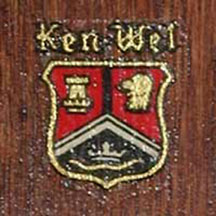
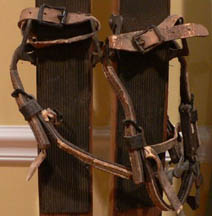
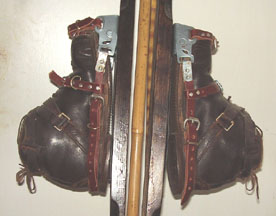

Restored Nordic (Cross-Country) Skis
Ken-Wel Decal
Bindings (before)
Gerber Ski Boots and Restored Bindings
The Skis -- ready for the car top
These bindings are totally deadly! A broken leg or ankle is almost guaranteed
(click to enlarge)
After my pleasant experience with the Nordic Skis, I decided to try my hand at a pair of downhill skis that had materialized in the Episcopal Thrift Shop down the way. Midway through the restoration, I was informed that the exact same skis were featured on the cover of the March 17, 1937 issue of LIFE Magazine -- and so they were.

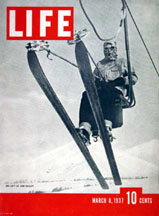
The Downhill Skis
Cover of LIFE Magazine March 17, 1937
(click to enlarge)
Polo
Polo never entered my mind, it being a sport for the ultra-wealthy. However, my service in the Navy found me stationed in Thailand in the late 1960s in an administrative capacity. Apparently King Bhumibol thought that all U.S. Officers were skilled at horsemanship, and requested that the US Military mission form a polo team to compete with the palace guard. We first begged off by noting that due to the war, we couldn't transport our ponies. The King kindly offered us the use of his own horses, so we were somewhat stuck. Our next gambit was that we hadn't played together and we might need months of practice. Immediately, a sergeant from the palace guard was dispatched to get us in shape. We got some encouragement from the State Department who wanted to do everything possible to help US-Thai relations. Of all things, a dozen mildewed polo saddles arrived by air from Fort Riley, once the home of the US Horse Cavalry. Thus began the tortuous history of the US Combined Services Polo Team. Our sergeant quickly realized that most of us didn't know one end of the horse from another and was very patient in helping us along. Under his able tutelage, we were actually able to play polo in about two months.
We did not, however, put up much of a show against even the fourth string Guards team, although we scored a few goals against a Junior High School team. I was transferred out and I understand that the USCSPT continued into the 1970s, improving in ability to win the respect of the guards. Nobody seemed to want the ratty equipment that we were issued, so I sent it to my Dad as proof that I was indeed an Officer and Gentleman. I did not contribute to this. His Majesty the King should be commended for his generous nature and great patience, at least where American pickup polo teams are concerned.

Aritfacts of my brief Polo Career
That's a Robinson Saddle
.. and an original Roller derby poster...
(click to enlarge)
The only thing that I have to show of my Polo career is a Robinson saddle that saw better days in the 1920s, a very nice pair of riding boots (that I bought myself), a helmet and a mallet, all of which sat in boxes in my parents' house for nearly 25 years. These artifacts are now is displayed in a corner of my office.
Fencing
I had about six lessons in Fencing as part of a school play. Basically, they concentrated on how to make things look realistic without killing anyone. Later, I found this fencing mask at a flea market. That is the extent of my experience with swords and swordplay.
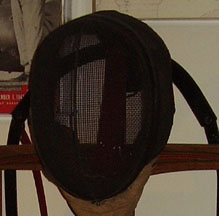

The Fencing Mask
(click to enlarge)
Home | About Lindy | 1940s Collectibles | Upcoming Events | Vintage Clothing
The Guide - Establishments - Travel - Accessories
Music | Links | Photo Gallery | Extras | Contact